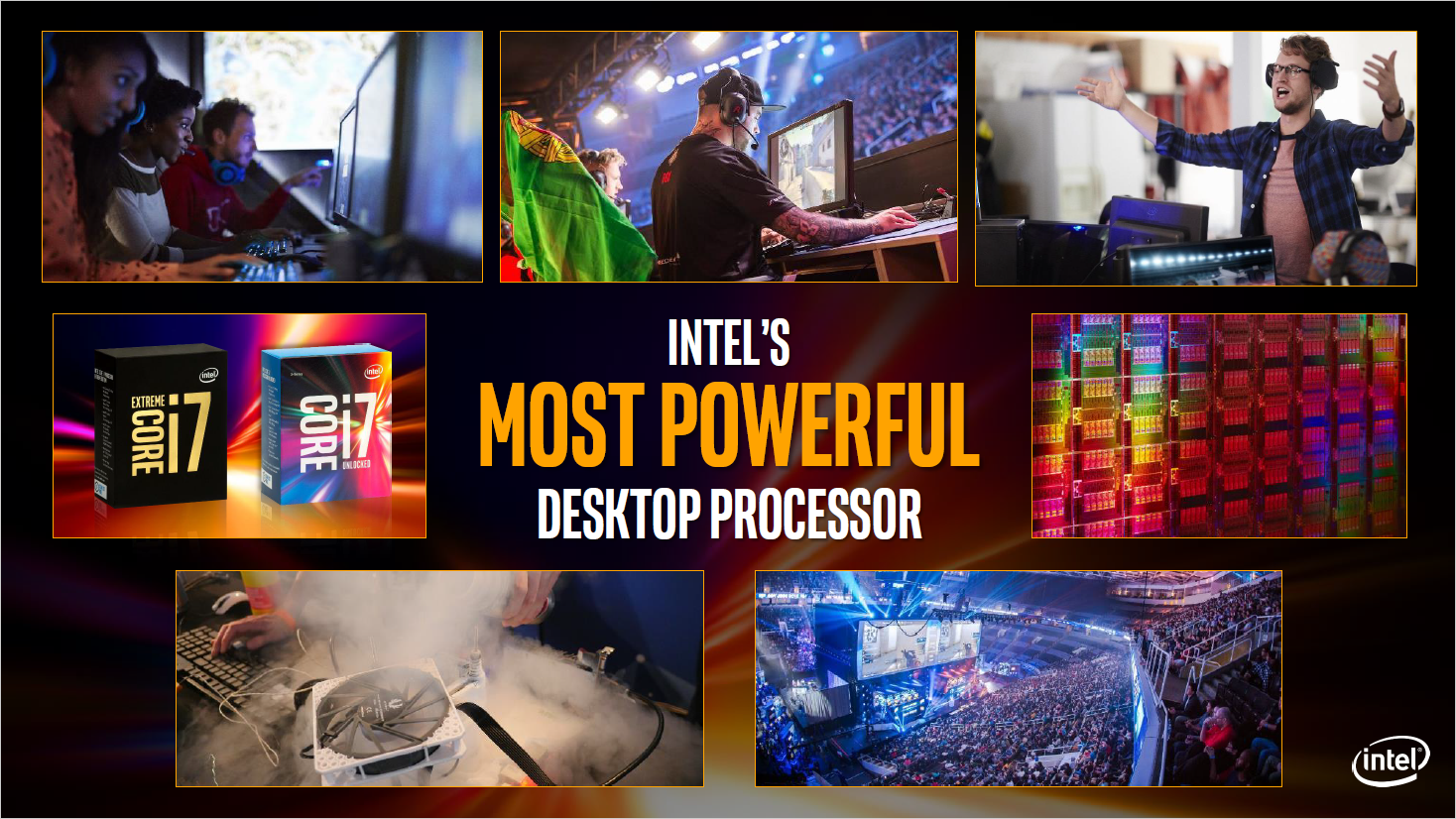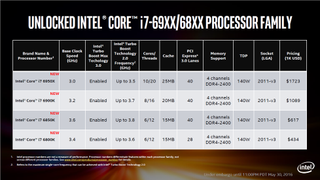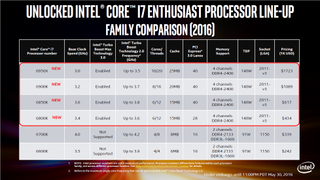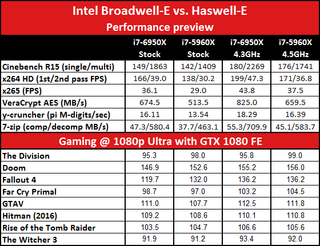Broadwell-E i7-6950X performance preview
Superfast and also super expensive.

'Wow.' That was the word that came out of my mouth when I saw the launch information for Intel's latest enthusiast platform processors, codename Broadwell-E. Going back to the Bloomfield days and LGA1366, Intel has bifurcated their consumer desktop processors into two platforms, one for mainstream users and one for 'enthusiasts.' But when Intel says enthusiasts, what they often seem to be saying is "people that have a lot of disposable income." The first LGA1366 processors (and going back further, the Core 2 and Pentium 4 Extreme Edition processors) defined a new price point for the top-of-the-line parts: $999. That price has basically held steady for more than a decade, all the way to the previous king of the hill, the Core i7-5960X.
If you haven't guessed yet, Broadwell-E kicks that previous price to the curb, with the new i7-6950X halo part rocking a price tag of $1723—and that's for bulk 1000 unit orders from Intel. And what exactly does this new monster CPU get you? It gets you 10 cores, two more than the already impressive eight cores on the i7-5960X. It seems Nvidia isn't the only company going after the magical number 10 these days. Three additional parts round out the Broadwell-E offerings, the 8-core i7-6900K, and the 6-core i7-6850K and i7-6800K. Here's the quick overview:

Welcome to the Order of 10
Compared to the previous generation Haswell-E family, the 10-core 6950X has the same clock speed range as the 5960X, and the 8-core 6900K potentially nets you a 200MHz increase while maintaining the core count. The 6850K looks extremely similar to the 5930K, with a 100MHz clock increase, and the 'budget' 6800K adds 100MHz to the base clock of the 5820K and continues to include 28 PCIe lanes instead of 40 lanes. Of course, the architecture in Broadwell-E is improved over Haswell-E, so even at identical clock speeds it should deliver better performance. It's also manufactured on Intel's current-best 14nm Tri-gate transistor process, where Haswell-E is a 22nm Tri-gate design. But in all cases you're looking at $20-$60 more than the Haswell-E equivalent, with the 10-core part defining a new uber-processor consumer market segment.
If you're part of the PC Gamer community and you're wondering why anyone would buy such a processor, let's just get this out of the way: it's not necessary for gaming, not in the slightest. What's more, the stock clock speeds on the enthusiast platform CPUs are quite a bit lower than those you'll find on the i7-6700K and i7-4790K, so you're faced with trading clock speed for core count. And make no mistake: these processors can use a lot more power than their mainstream brothers, with 140W TDP compared to 91W on Skylake (and 88W on Devil's Canyon, the 4790K).
But we're also the guys behind Maximum PC, and we're far more into tinkering with our hardware than the average gamer. We've been building custom PCs for decades, and we have a passion for squeezing every last ounce of performance out of our hardware. We understand that some people just want a reliable car to get them where they need to go, and for those folks, the mainstream LGA1151 parts (or even LGA1150) are great. But if you've ever edited a video and drummed your fingers impatiently on the desk, waiting for it to encode…well, more cores can be great for that sort of work.
No enthusiast is actually going to buy one of these processors to run them at stock clocks. They're built for overclocking, and like the Haswell-E line, all of the new Broadwell-E processors have fully unlocked multipliers. They also have more PCI Express lanes, quad-channel memory support, and a few other extras to entice people to take the plunge. If you're simply after more cores, Intel has offered Xeon processors with up to 18 cores for over a year, and earlier this year they launched a 22-core part, but clock speeds are even lower, and those parts are multiplier locked. (And don't even look at the prices if you think $1723 for a 10-core part is expensive….) In contrast, these enthusiast parts are for people that want to add custom cooling—they don't even include a heatsink for any of these processors—and then push the limits as far as they'll go. Oh, and if you happen to run applications that benefit from multiple cores, yes, these chips are screaming fast.

Here's a different look at Intel's current enthusiast processors—but in this case, 'enthusiast' means they have unlocked multipliers and they're ready for overclocking. All of these are listed as 6th Generation Core processors, though Skylake is technically a newer architecture and offers some advantages over Broadwell (like a 6-wide instruction prefetch rather than 4-wide). Besides socket differences, we wouldn't worry too much about the memory speeds—all the Z170 motherboards we've looked at support speeds well in excess of DDR4-2133, and we've used kits rated at DDR4-3200 and more. Not that higher memory speeds really matter that much in practice. Given the X99 platform hasn't changed with the introduction of Broadwell-E—most X99 motherboard makers already have updated BIOS versions available to support the new processors—this launch is really going to be about performance.
The biggest gaming news, reviews and hardware deals
Keep up to date with the most important stories and the best deals, as picked by the PC Gamer team.
We've been feverishly testing over the past week or two, but we're not quite ready to cover all of the parts just yet (we've also been busy checking out the GTX 1070). Instead, we're going to provide a preview today, showing how the i7-6950X stacks up against the previous champ, the i7-5960X. We'll be back later in the week with results from the other Broadwell-E parts, along with comparisons to other processors. For now, here's a preview of the new CPU heavyweight champion of the world.
Stock and overclock performance preview
I know I just said that no enthusiasts run stock clocks on these types of processors, but let's be thorough and see how they perform both with and without overclocking. We have results from two CPUs—one old, one new—running both stock and overclocked. We've paired these processors with the current fastest GPU, the GTX 1080. That should help differentiate the CPUs when it comes to gaming performance, but even then we don't expect to see much of a gap. If we were running a slower graphics card like a GTX 970, we'd basically end up GPU limited in every single game in our test suite. That's another way of saying that anyone looking to run the type of graphics card we normally recommend is probably not going to want/need a $1750 CPU. Shocking, right?

There's plenty more to say, but for now the above chart will tell you most of what you need to know. We're still working on overclocking, and BDW-E has some new features like per-core overclocking that could prove useful, but at present we were able to hit 4.5GHz on the i7-5960X while we haven't been able to get beyond 4.3GHz (stable) on the i7-6950X. In most cases, it doesn't matter and the 6950X takes the win, though y-cruncher in particular has a habit of pushing overclocked CPUs to the limit and can get into uncomfortably high temperatures. (It's my new favorite CPU stress test.)
Looking at a few of the results, like the overclocked 2269 in Cinebench vs. 1741; that's a rather large 30 percent improvement from Broadwell-E! x264 HD also shows a similar improvement in performance with the 10-core processor. So yes, in the right workloads the additional cores can make a big difference; if you're doing computationally intensive work that scales with multi-threading, like video editing or professional CAD work, the price of admission might be worthwhile.
What about gaming? We're still in the process of testing on other CPUs, but what we have shows that in most games, everything is pretty close to margin of error. Fallout 4 is the only game to show more than a ten percent gap between our lowest and highest result, with Far Cry Primal (nearly eight percent) and Doom (six percent) also showing a slight difference. Most of that comes thanks to overclocking, as the stock vs. stock and OC vs. OC results are much closer. We'll be running updated results for i7-6700K and some other processors for our full review, but no one should expect the move from 4-core to 6-core, 8-core, or 10-core to really make much of a difference in games.
Check back later this week for our full performance analysis, breakdown of new features, and performance results for the other Broadwell-E processors.
Jarred's love of computers dates back to the dark ages when his dad brought home a DOS 2.3 PC and he left his C-64 behind. He eventually built his first custom PC in 1990 with a 286 12MHz, only to discover it was already woefully outdated when Wing Commander was released a few months later. He holds a BS in Computer Science from Brigham Young University and has been working as a tech journalist since 2004, writing for AnandTech, Maximum PC, and PC Gamer. From the first S3 Virge '3D decelerators' to today's GPUs, Jarred keeps up with all the latest graphics trends and is the one to ask about game performance.
Most Popular

